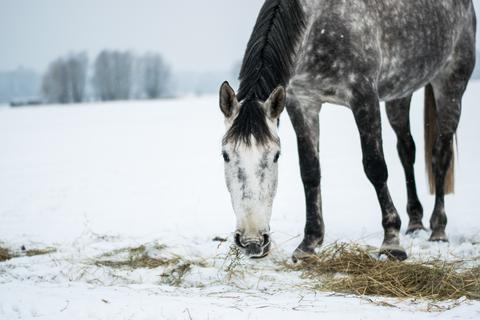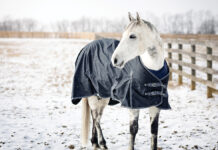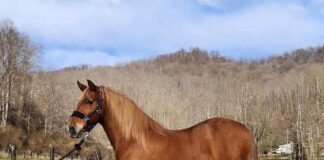As winter draws closer, it’s time to start thinking about your horse’s feeding plan. Many people don’t realize that their horse will need more calories to keep warm in cold weather, resulting in a seemingly sudden weight loss over the winter. Rather than react after the fact, it’s easier and healthier for your horse if you take steps to keep his weight consistent throughout the season. A horse that is too thin is more prone to illness, which leads to vet bills that all horse owners would rather avoid.

2. Add warmth with forage. Although healthy horses with natural winter coats can tolerate cold temperatures (down to 10 degrees Fahrenheit) without spending extra energy to keep warm, wind and precipitation make that more difficult. Even with a blanket, horses can burn calories shivering if the weather is extreme. The breakdown of fiber (roughage) by bacteria in the horse’s large intestine gives off significant amounts of heat, so providing extra hay is an easy way to help your horse stay warmer.
3. Keep an eye on weight. Whether your horse gains or loses weight very easily, it can be bad news for you as a horse owner. Thick winter hair can mask weight loss, so use your hands to feel for areas of fat coverage using the Henneke body condition score (BCS) system. Your horse’s BCS can range from 1 to 9 depending on how much fat can be felt on his body; scores of 4 to 6 are ideal for all classes of horses. Endurance horses and those in very hard work will tend toward the lower end of ideal, while easy-keeper breeds in minimal work will tend toward the top end. Try to anticipate your horse’s feeding needs before he becomes too thin or too fat.
4. A note on easy-keepers. Obese horses are at increased risk for laminitis, insulin resistance and other metabolic disorders. Winter should be no different from any other time of year for an easy-keeper: His feed intake should be monitored, with grain and calorie-rich hays (such as alfalfa) limited or avoided entirely if possible. A good-quality grass hay fed freely, plus ration balancer pellets to meet vitamin and mineral requirements, are probably all he needs. Exercise is also of great assistance when trying to get unhealthy weight off of a horse, so try to ride or longe your horse in the winter if you have an easy-keeper.
5. To feed or not to feed: round bales. Round bales are a very convenient way to provide plentiful forage to herds of pasture-kept horses during the winter, assuming you have the equipment to move them. One of the biggest drawbacks is the amount of wastage that will occur if you feed one on the ground. To avoid this, specially designed round bale feeders are available to keep the hay out of the mud and prevent trampling and much of the wastage. Even with a feeder, round bales should not be fed unless they can be finished off in under a week, since unhealthy mold will start to grow in the hay. If you do feed round bales, ask your vet about vaccinating for botulism, which horses can contract from small dead animals that may get caught up in the hay during the baling process; these are harder to see and weed out than they would be in a small square bale.
6. Don’t forget water. Perhaps the most important winter feeding tip is to make sure your horse has an unfrozen supply of clean, fresh water at all times. The leading cause of impaction colic is dehydration, so avoid it by checking buckets and troughs daily. You can also use heated buckets, heated automatic waterers or a floating trough heater to warm the water to a more enticing temperature and encourage more drinking. Continue to clean and refill buckets and tanks daily and check for any shorts in the wiring, which could produce an electric current in the water and keep horses from drinking it.
With these tips in mind, you’ll be ready to face winter and keep your horse properly fed and hydrated until spring weather returns with warmer temperatures.
Holly Caccamise has an M.S. in Animal Science with a specialization in equine nutrition.
This article originally appeared in the November 2011 issue of Horse Illustrated. Click here to subscribe.





